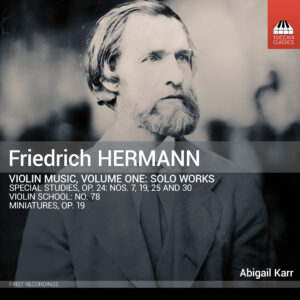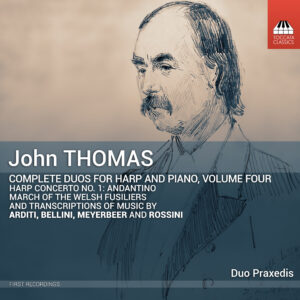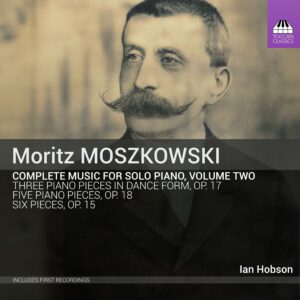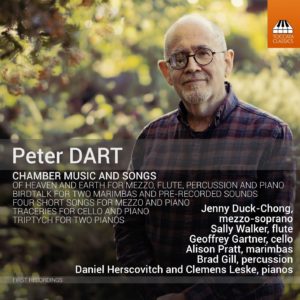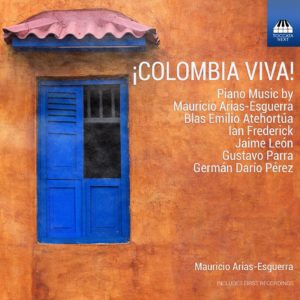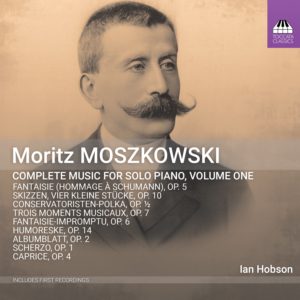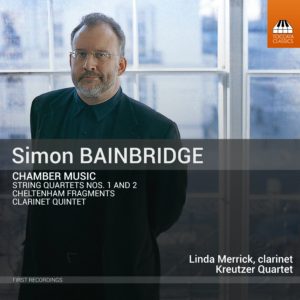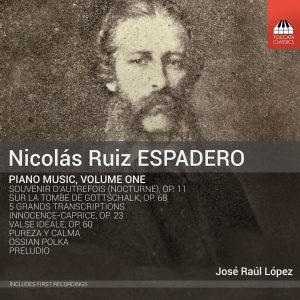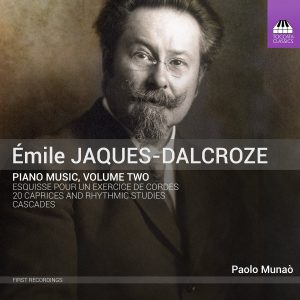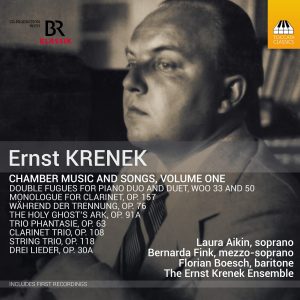Search Results for "MrWhosetheboss 5 Tech Products changed life video description site:youtube.com" – Page 2
Friedrich Hermann: Violin Music, Volume One – Solo Works
The German violinist, violist and composer Friedrich Hermann (1828–1907) spent the six decades of his adult life teaching at the Leipzig Conservatoire and, although his works include a symphony, a string quartet and numerous other chamber pieces for strings, by far the largest part of his output is pedagogical in nature. But he pumped his teaching pieces full of imagination, as the studies here demonstrate. Even though the twenty Miniatures published in 1881 are intended for student violinists, many of them are tiny tone-poems intended both to engage the attention of their players and challenge their techniques – and their mix of poetry and humour should also appeal to adult listeners.
Abigail Karr, violin
John Thomas: Complete Duos for Harp and Piano, Volume Four
Harpist to Queen Victoria, the Welsh composer John Thomas (1826–1913) also wrote prolifically for his own instrument, both for solo harp and for duos of two harps or harp and piano – a combination where the different sounds of the two instruments enhance the clarity of the texture. Thomas’ original works use the elegant Romantic style of his own day, but he often drew on Welsh folksong for his inspiration and also left a generous legacy of transcriptions, especially of operatic favourites. Although some of his music was intended for the Victorian drawing room, other pieces require a virtuoso technique – and all of it has a thoroughly engaging melodic appeal.
Duo Praxedis
Praxedis Hug-Rütti, harp
Praxedis Geneviève Hug, piano
John Thomas: Complete Duos for Harp and Piano, Volume Three
Harpist to Queen Victoria, the Welsh composer John Thomas (1826–1913) also wrote prolifically for his own instrument, both for solo harp and for duos of two harps or harp and piano – a combination where the different sounds of the two instruments enhance the clarity of the texture. Thomas’ original works use the elegant Romantic style of his own day, but he also left a generous legacy of transcriptions, especially of operatic favourites. Although some of his music was intended for the Victorian drawing room, other pieces require a virtuoso technique – and all of it has a thoroughly engaging melodic appeal.
Duo Praxedis
Praxedis Hug-Rütti, harp
Praxedis Geneviève Hug, piano
Derek B. Scott: Orchestral Music, Volume Three
Derek Scott, born in Birmingham in 1950, has an international reputation as an historian of the British music hall and other forms of light entertainment. But he is an outstanding composer in his own right – a master craftsman and natural tunesmith, who manages to unite good humour, unerring technique and deep feeling in music of immediate appeal. Although the works recorded here represent his most recent harvest of orchestral music, for many of them he revisited material composed earlier in his career, using it as the basis for a series of new scores, some exhibiting a very English sense of whimsy, others concerned with deeper matters – one, indeed, inspired by the war in Ukraine. This album has been released with remarkable speed: it was recorded only on 15–18 May this year.
Liepāja Symphony Orchestra
Paul Mann, conductor
Ingus Novicāns, horn
Līga Baltābola and Jānis Baltābols, violins
Klāvs Jankevics, cello
Gertruda Jerjomenko, harpischord
John Thomas: Complete Duos for Harp and Piano, Volume Two
Harpist to Queen Victoria, the Welsh composer John Thomas (1826–1913) wrote prolifically for his own instrument, both for solo harp and for duos of two harps or harp and piano – a combination where the different sounds of the two instruments enhance the clarity of the texture. Thomas’ own compositions use the elegant Romantic style of his own day, but he also left a generous legacy of transcriptions, with no fewer than fourteen Schubert songs recorded on this second volume of his complete duos for harp and piano. Although some of his music was intended for the Victorian drawing room, other pieces require a virtuoso technique – and all of it has a thoroughly engaging melodic appeal.
Duo Praxedis
Praxedis Hug-Rütti, harp
Praxedis Geneviève Hug, piano
Moritz Moszkowski: Complete Music for Solo Piano, Volume Two
Although Moritz Moszkowski (1854–1925) wrote a considerable quantity of piano music, only a single piece, ‘Étincelles’, made it into the repertoire, not least because Horowitz enjoyed playing it. The early works on this second instalment in Ian Hobson’s survey of Moszkowski’s complete music for solo piano reveal a debt to Mendelssohn and Schumann, but the effortless craftsmanship heard here already justifies a later remark of Paderewski’s: ‘After Chopin, Moszkowski best understands how to write for the piano, and his writing embraces the whole gamut of piano technique’. Most of the pieces in Opp. 15 and 18 are attractive salon miniatures, but the Three Piano Pieces in Dance Form, Op. 17, are extended Lisztian essays that showcase Moszkowski’s mastery of the keyboard and his command of form.
Ian Hobson, piano
Derek B. Scott: Orchestral Music, Volume Two
Derek Scott, born in Birmingham in 1950, has an international reputation as an historian of the British music hall and other forms of light entertainment. But he is an outstanding composer in his own right, his music treading a fine line between a very English whimsy and a profoundly felt and natural response to his (often Celtic) subject matter. These works reveal a master craftsman and natural tunesmith, who manages to unite good humour, unerring technique and deep feeling in music of immediate appeal. His two symphonies – originally written for brass band – embody a return to the formal, Classical clarity of Haydn, though expressed with the satisfyingly beefy textures of the modern orchestra. He lists among his influences Shostakovich and Sibelius and, less predictably, The Beatles and The Kinks.
Liepāja Symphony Orchestra
Paul Mann, conductor
Derek B. Scott: Six Song-Cycles for Baritone and Chamber Ensemble
Derek Scott, born in Birmingham in 1950, has an international reputation as a leading historian of the British music hall and other forms of light entertainment. But he is an outstanding composer in his own right, his music treading a fine line between a very English whimsy and a profoundly felt and natural response to his subject matter. These six song-cycles – with influences ranging from Vaughan Williams to The Beatles – reveal a master craftsman and natural tunesmith, who manages to unite good humour, unerring technique and deep feeling in music of immediate appeal, setting texts by poets who include Burns, Hardy, Shakespeare, Swift, Wordsworth, Yeats and the composer himself.
James Atkinson, baritone
Lynn Arnold, piano (Tracks 1-8, 14-26)
Tippett Quartet
John Mills and Jeremy Isaac, violins
Lydia Lowndes-Northcott, viola
Božidar Vukotić, cello
Peter Dart: Chamber Music and Songs
Painters sometimes talk about the intensity of the light they encounter in Australia. Peter Dart, born in Sydney in 1953, brings something of that brightness to his compositions, which are further animated by buoyant rhythms and a lively sense of humour, even mischief. They are, at the same time, anchored in a secure command of counterpoint, and given a timeless quality by his fondness for modal harmony. Most important of all, the technical mastery that gives these works their surefooted appeal is suffused with straightforward human warmth.
Daniel Herscovitch, piano (Tracks 1 – 12, 14 – 17)
Clemens Leske, piano (Tracks 1 – 3)
Jenny Duck-Chong, mezzo-soprano (Tracks 4 – 7, 14 – 17)
Sally Walker, flute (Tracks 15 – 16), piccolo (Tracks 14 – 17)
Geoffrey Gartner, cello (Tracks 8 – 12)
Brad Gill, percussion (Tracks 14 – 17)
Alison Pratt, marimbas (Track 13)
¡Colombia Viva!: Piano Music by Mauricio Arias-Esguerra, Blas Emilio Atehortúa, Ian Frederick, Jaime León, Gustavo Parra, Germán Darío Pérez
In this album Mauricio Arias-Esguerra offers a kaleidoscopic view of recent Colombian piano music, highlighting its striking stylistic variety. Germán Darío Pérez sees a traditional dance through a jazzy lens, and Blas Emilio Atehortúa takes a post-serial approach in his Preludio, Variaciones y Presto Alucinante. The influence of progressive rock music can be heard in Gustavo Parra’s Pavec Lingus, as can Jaime León’s love of US American music in his Made in U.S.A. preludes; and there is techno and angst in Ian Frederick’s Suite Catrina. Arias-Esguerra’s own contributions are highly contrasted, with lyricism in his Arizona Mirage and rhythmic drive in his Toccata Bachkovsky.
Mauricio Arias-Esguerra, piano
Moritz Moszkowski: Complete Music for Solo Piano, Volume One
Moritz Moszkowski (1854–1925) wrote a considerable quantity of piano music, but it is generally remembered today only for a single piece, ‘Étincelles’, which Horowitz enjoyed playing. The early works on this first instalment in Ian Hobson’s survey of Moszkowski’s complete music for solo piano reveal a debt to Mendelssohn and Schumann, but the craftsmanship already justifies a later remark of Paderewski’s: ‘After Chopin, Moszkowski best understands how to write for the piano, and his writing embraces the whole gamut of piano technique’.
Ian Hobson, piano
Simon Bainbridge: Chamber Music
The composing career of Simon Bainbridge (born in London in 1952) is spanned by the four chamber works in this album, all of them cast as single narrative spans. The First String Quartet, written when its composer was not yet twenty, blends lyricism and pointillism, rather as if it were recasting abstract poetry in sound; and the recent Second offers a kaleidoscopic tableau of colour and nervous energy inspired by visual art. In his Cheltenham Fragments, as the title suggests, Bainbridge uses mosaic technique to build up textures and thematic outlines. And the long lines of the virtuosic Clarinet Quintet generate fleetfooted whirlwinds as they unfold. Linda Merrick and the Kreutzer Quartet worked closely with the composer on the preparation of these recordings.
Linda Merrick (Clarinet)
Kreutzer Quartet
Peter Sheppard Skærved, violin
Mihailo Trandafilovski, violin
Clifton Harrison, viola
Neil Heyde, cello
Nicolás Ruiz ESPADERO: Piano Music, Volume One
In this second volume of his survey of Cuban composers for the piano, José Raúl López presents the work of Nicolás Ruiz Espadero (1832–90), the most prominent name in Cuban music in the second half of the nineteenth century, both at home and abroad. Espadero’s output ranges from delicate Chopinesque salon miniatures to barnstorming Lisztian operatic paraphrases that demand a fearsome virtuoso technique to do justice to their high-Romantic swagger.
José Raúl López, piano
Émile Jaques-Dalcroze Piano Music, Volume Two
The Swiss composer Émile Jaques-Dalcroze (1865–1950) is best remembered for his development of Eurhythmics, which teaches the appreciation of music through movement. But Jaques-Dalcroze, who studied with Delibes and Fauré in Paris and with Bruckner and Fuchs in Vienna, was a considerable composer in his own right, with operas, cantatas and orchestral works among his substantial output. His 20 Caprices and Rhythmic Studies constitute an important but hitherto unknown set of character-studies, combining a relaxed lyricism with technical challenges of considerable subtlety for the player.
Notes en Français
Paolo Munaò, piano
Ernst Krenek: Chamber Music and Songs, Volume One
This recording of music by Ernst Krenek (1900–91) covers almost half a century of his compositions, and shows the sheer range of his creativity: from early piano fugues written for his teacher, Franz Schreker, via elegant fin de siècle Viennese lyricism to a relaxed application of Schoenberg’s dodecaphonic technique – often enlivened with a surprising degree of charm and a knowing sense of humour.
Laura Aikin, soprano (Tracks 2 – 4)
Bernarda Fink, mezzo-soprano (Track 7)
Florian Boesch, baritone (Track 7)
The Ernst Krenek Ensemble
Matthias Schorn, clarinet (Tracks 2 – 4)
Hanna Weinmeister, violin (Tracks 2 – 6)
Christian Eisenberger, violin (Tracks 2 – 4, 8 – 9)
Tatjana Masurenko, viola (Tracks 11 – 15)
Dorothea Schönwiese, cello (Tracks 2 – 6)
Anthony Spiri, piano (Tracks 1, 5 – 9, 21)
with Herbert Maderthaner, oboe (Track 10)
Lily Francis, viola (Tracks 2 – 4, 10)
Nina Tichman, piano (Tracks 1, 21)
Jeremy Dale Roberts: Chamber and Instrumental Music
Jeremy Dale Roberts (1934–2017) was a unique figure on the British musical landscape: as a composer, he steered a path between traditional tonality and modernism, developing a language that can range from aching, pastoral lyricism to wild, freewheeling energy. This album – to which Dale Roberts referred as ‘a kind of testament’ – counterpoints works from the beginning and end of his career, all distinguished by his unmistakable sense of drama and poetry and his peerless technical command. The performers here worked intensely with the composer over a number of years, and he was involved with every aspect of these recordings, from initial rehearsals up to the final edits.
Peter Sheppard Skærved, violin (Track 1)
Roderick Chadwick, piano (Tracks 1 – 2)
Bridget MacRae, cello (Tracks 3 – 6)
Kreutzer Quartet (Tracks 3 – 6)
Peter Sheppard Skærved, Mihailo Tranda lovski, violins
Morgan Goff, viola
Neil Heyde, cello
Stay In the Know
JOIN THE TOCCATA NEWSLETTER
"*" indicates required fields
By visiting our site, you agree to our privacy policy regarding cookies, tracking statistics, etc.
